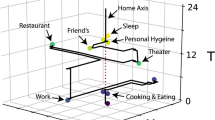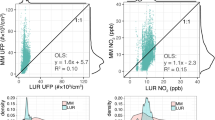Abstract
A personal exposure study was conducted in New York City as part of the Urban Dispersion Program (UDP). It examined the contact of individuals with four harmless perflourocarbon tracers (PFT) released in Midtown Manhattan with approval by city agencies at separate locations, during two types of experiments, completed during each release period. Two continuous 1 h release periods separated by a 1.5 h ventilation time were completed on 3 October 2005. Stationary site and personal exposure measurements were taken during each period, and the first half hour after the release ended. Two types of scripted exposure activities are reported: Outdoor Source Scale, and Outdoor Neighborhood Scale; requiring 1- and 10-min duration samples, respectively. The results showed that exposures were influenced by the surface winds, the urban terrain, and the movements of people and vehicles typical in urban centers. The source scale exposure data indicated that local conditions significantly affected the distribution of each tracer, and consequently the exposures. The highest PFT exposures resulted from interaction of the scripted activities with local surface conditions. The range measured for 1- min exposures were large with measured values exceeding 5000 ppqv (parts per quadrillion by volume). The neighborhood scale measurements quantified exposures at distances up to seven blocks away from the release points. Generally, but not always, the PFT levels returned quickly to zero indicating that after cessation of the emissions the concentrations decrease rapidly, and reduce the intensity of local exposures. The near source and neighborhood personal exposure route results provided information to establish a baseline for determining how a release could affect both the general public and emergency responders, and evaluate the adequacy of re-entry or exit strategies from a local area. Finally, the data also show that local characteristics can produce “hot spots”.
This is a preview of subscription content, access via your institution
Access options
Subscribe to this journal
Receive 6 print issues and online access
$259.00 per year
only $43.17 per issue
Buy this article
- Purchase on Springer Link
- Instant access to full article PDF
Prices may be subject to local taxes which are calculated during checkout















Similar content being viewed by others
References
Barr D.B. Human exposure science: a field of growing importance. J Expos Anal Environ Epidemiol 2006: 16: 473.
Catskill Tire Fire. 1990 Catskill, New York, OSC Report Region II, February, 1989–April 1990.
Cohen-Hubel E.A., Sheldon L., Burke J.M., McCurdy T.R., Berry M.R., Rigas M.L., Zartarian V.G., and Freeman N.C.G. Children's exposure assessment: a review of factors influencing children's exposure, and the data available to characterize and assess that exposure. Environ Health Perspect 2000: 108: 475–486.
Dietz R.N. Perfluorocarbon tracer technology. In: Sandroni S. (Ed.) Regional and Long-Range Transport of Air Pollution. Elsevier: Amsterdam, 1987 pp 215–247.
Draxler R.R., Dietz R.N., Lagomarsino R.J., and Start G. Across north america tracer experiment (ANATEX): sampling and analysis. Atmos Environ 1992: 25A: 2156–2815.
Georgopoulos P.G., and Lioy P.J. From theoretical aspects of human exposure and dose assessment to computational model implementation: the MOdeling ENvironment for TOtal Risk Studies (MENTOR). J Tox Environ Health 2006 Part B (in press).
Hanna S., Allwine J., Reynolds M., Kalb P., Heiser J., and Lioy P. Description of the Madison 2005 (MSG 05). Tracer Experiment in New York City 2004 Harvard School of Public Health PO65, MSG05, 1 November, 2004.
Lioy P.J. Exposure analysis and the biological response to a contaminant: a melding necessary for the environmental health sciences. J Expos Anal Environ Epidemiol Suppl 1992: 2: 19–24.
National Research Council (Ed). Human exposure assessment for airborne pollutants: advances and opportunities. Committee on Advances in Assessing Human Exposure to Airborne Pollutants. National Academy Press: Washington, DC, 1991 p. 321.
Reinhart Tire Fire HETA 84-044-1441 Titled Health Hazard Evaluation Report 1984 Tire Fire Investigation, Evert, Washington 25 September to 10 October 1984.
Reynolds R.M., and Brookhaven National Laboratory. The Madison Square Garden Dispersion Study (MSG-05) Meteorological Data Report 2006 4 January 2006.
Steve H., Coirier W., Kim S., Hansen O.R., Brown M., Huber A., Chan S., Camelli F., and Reynolds R.M. Five computational fluid dynamics models applied to manhattan. Bull Am Meteor Soc in press.
Watson T.B., Heiser J., Kalb P., Dietz R.N., Wilke R., Weiser R., and Vignato G. The New York City Urban Dispersion Program March 2005 Field Study: Tracer Methods and Results 2006 Brookhaven National Laboratory, BNL-75552-2006 (Report), January 2006.
Acknowledgements
This study was part of a large, multi-agency project that has involved many collaborators. We gratefully acknowledge the assistance of some of the major contributors for their outstanding and critical support that has made completion of this work possible: Emergency Response Staff Region II, Margaret Chong, Kimberly Camp, Joe Cosentino, Bill Sy, Chester Norman, Carl Pellegrino, Mike Ferriola, Arlene Anderson, Esther Nelson, Marty Freeman, Norrell, Don Wright, Jennifer Feranda, Jim Haklar, Nick Magriples for the exposure measurements, and Eric Mosur, EPA Region II for design issues Other collaborators of note are: Tony Fainberg (DHS Program Manager), Rick Fry (DTRA Program Manager), Paul Kalb (Brookhaven National Laboratory) and Jerry Blancato (EPA Program Manager) prior to and during the field study for guidance and support, Jerry Allwine (Pacific Northwest National Laboratory, PNNL) who serves as the UDP Science Lead, contributing planning, experimental design, logistical support and overall project management of the field study and provided review/comments, Kevin Clark (NYC Office of Emergency Management) facilitated inter-agency coordination, Joseph Kinney (New Yorker Hotel) provided invaluable logistical support, Bernadette Nation, Emergency Response Unit, NYC Dept of Small Business Services as liaison with local business, Gary Parker and other members of local community boards helped inform the community about the objectives and safety of the field study, Steve Hanna (Harvard School of Public Health) scientific planning for this study, Noel Blackburn (BNL), Reginald Blake (New York City College of Technology), and Derrick Skeet (Medgar Evers College), Peter Bengtson (PNNL), Kay Cordtz (BNL), Mona Rowe (BNL) and Julie Flaherty (PNNL). Ms. Linda Everett (EOHSI) for graphics. Drs. Lioy, Georgopoulos and Isukapalli are funded by US EPA-funded Center for Exposure and Risk Modeling (CERM) under Cooperative Agreement #CR827033 and the NIEHS Center Grant (ES05022-1551). Release of PTF tracers by BNL was approved by NYC agencies.
Author information
Authors and Affiliations
Corresponding author
Additional information
Disclaimer: The United States Environmental Protection Agency through its Office of Research and Development (ORD) partially funded and collaborated in the research described here under assistance agreement CR 83162501 to the Environmental and Occupational Health Sciences Institute, and funded the PFT analyses under contract EPD 04068 with Battelle Memorial Institute and its subcontractor, Brookhaven National Laboratory. The research and this manuscript have been subjected to Agency review and approved for publication.
Rights and permissions
About this article
Cite this article
Lioy, P., Vallero, D., Foley, G. et al. A personal exposure study employing scripted activities and paths in conjunction with atmospheric releases of perfluorocarbon tracers in Manhattan, New York. J Expo Sci Environ Epidemiol 17, 409–425 (2007). https://doi.org/10.1038/sj.jes.7500567
Received:
Accepted:
Published:
Issue Date:
DOI: https://doi.org/10.1038/sj.jes.7500567
Keywords
This article is cited by
-
Critical assessment and integration of separate lines of evidence for risk assessment of chemical mixtures
Archives of Toxicology (2019)
-
Simulating real-world exposures during emergency events: studying effects of indoor and outdoor releases in the Urban Dispersion Program in upper Manhattan, NY
Journal of Exposure Science & Environmental Epidemiology (2014)
-
ISEA2007 panel: Integration of better exposure characterizations into disaster preparedness for responders and the public
Journal of Exposure Science & Environmental Epidemiology (2008)



